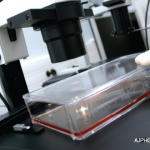“Almost all of the cancers are obvious and not obscure, and you don’t need to do a total body MRI to find them,” Dr. Plotz advised. “Follow up every abnormal test that you find that is not a part of myositis. Don’t let it slip by, because that is where you will sometimes pick up a tumor that you didn’t suspect.”
Patients with dermatomyositis are at particular risk of interstitial lung disease, and high-resolution computed tomography (CT) should be used for diagnosis. “Lung disease can occur early or even precede myositis and, like skin disease, can be the first manifestation. You should be thinking about that possibility if you get a patient who has a dermatomyositis-like rash but you can find nothing else,” he said.
First-line therapy for myositis is generally prednisone, and second-line therapy can include methotrexate or azathioprine, intravenous immunoglobulin (IVIG), and cyclosporine. “IVIG is often effective for dermatomyositis, is often a sensible choice in cancer-associated myositis, is sometimes effective for polymyositis and esophageal or lung disease, but it is not significantly effective for IBM,” Dr. Plotz said. Results of treatment with biologics have been inconclusive, and stem-cell therapy has been ineffective.
“If therapy is failing, be prepared to rethink what you are doing, rebiopsy, and reevaluate from the beginning if the patient is not responding,” he said.
Metabolic Myopathies
Kenneth S. O’Rourke, MD, professor of rheumatology and immunology at Wake Forest School of Medicine in Winston-Salem, N.C., said that physicians will be better able to diagnose and treat patients with metabolic myopathies if they understand muscle metabolism and how muscle energy systems work “because there is a direct relationship between that and symptomatology. A metabolic myopathy is, at its heart, a condition where there is some process with impaired production of cellular energy [adenosine triphosphate] in muscle,” he said.
Glycogen storage disorders (GSDs)—for example, McArdle disease or muscle phosphorylase deficiency—present in several ways. The prototypical patient presents with muscle symptoms that develop after brief isometric exercise or less intense but sustained dynamic exercise such as sprinting, jogging several hundred yards, or ascending stairs or a slope. These patients fatigue quickly, but patients with McArdle disease may get a “second wind” about seven to 10 minutes into activity, which is “theoretically when the muscles are getting reinfused with more glucose and more free fatty acids,” Dr. O’Rourke said. Those patients who cannot get that second wind will likely have an alternate glycolytic defect. Further distinguishing patients with McArdle disease is the presence of chronic elevation of CK, even at rest.


